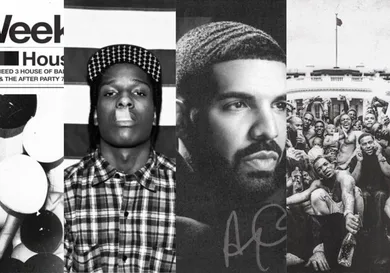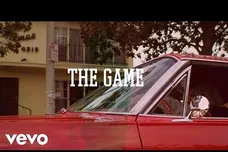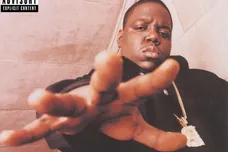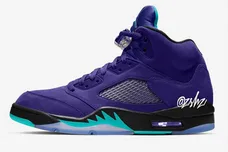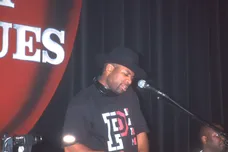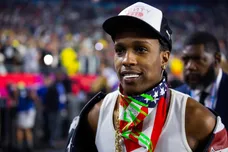At a time when our conception of music is constantly expanding and mutating to accommodate new methods of consumption, the album remains a sacred marker of artistic excellence. Though the once common practice of listening to an entire album in one sitting is being phased out by Spotify’s chart-defining playlists and YouTube’s algorithm, leaning into the obsession of our favorite records offers a glimpse into the music industry’s changing standards for the listening experience and also provides historical and cultural insights. Nostalgia can be a bitter pill to swallow, but looking back on beloved releases forces one to examine the context, both within an artist’s career and the greater musical picture. Has an album retained its initial replayability? Where does it stack up against similar projects, both from a genre and content standpoint? And perhaps most importantly, has it achieved a lasting, even traceable impact, or instead fallen out of favor as the years have gone by? These are just a few of the questions that were deployed when crafting this list. It's worth noting that the following rankings don’t pretend to be comprehensive; there will inevitably be releases that are omitted, whether realized or not. Rather, the goal in crafting this list was to create an enjoyable and debate-worthy romp down memory lane that was as objective as possible. While albums, mixtapes, and long-form projects are the primary focus, singles are occasionally referenced.
In any case, the past decade of hip hop and R&B has gifted listeners with an astounding host of releases worth revisiting in full. The rules are as follows:
1.) Each album must have been released starting from January 1, 2010 up to present day
2.) Mixtapes, free downloads, and Grammy-nominated projects are all eligible
3.) Each album must be from the hip-hop and/or R&B genre(s)
The rankings proceed from worst to best.
2013
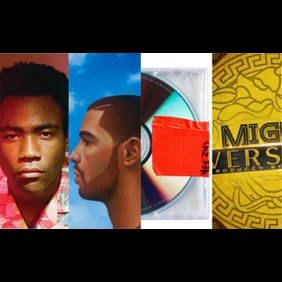
2013: new faces slowly creep in, while current mainstays thrive
As the accolades poured in for Kendrick Lamar, novel sounds and styles cropped up across the map. In Atlanta, Migos began perfecting their sound as natural descendants of their city’s coke rap subculture. Tracks like “Versace” and “Hannah Montana” married trap house platitudes with simple lyricism, frantic choruses, and a badgering repetition of quirky catchphrases and adlibs. Donald Glover, A.K.A. Childish Gambino, expanded his resume as a man of many talents by releasing Because the Internet, an album built on the notion that the internet has become the universal language of the digital age. Acid Rap was the introduction to Chance the Rapper, the eccentric character from Chicago whose lyrical acrobatics left a sharp impression. His mentor, Kanye West, repurposed the name of Western civilization’s messianic figure on Yeezus, an album of auditory assaults and rap rants that cranked up “loudness” and changed the way that we listen to music. The emotionally somber and insular Doris found Earl Sweatshirt looking to get back on track after his sudden retreat from the internet spotlight. Mature beyond his years but with a youthful keenness, Earl sounded unflappable in the jet-black landscapes of his own design. It was a shocking and disorienting release that skirted the mainstream, but quietly proved to be one of the year’s best.
----
The unspoken rivalry between Kendrick Lamar and Drake picked up serious steam in 2013, especially in the aftermath of Kendrick’s “Control” verse that shook the rap world to its core. On Nothing Was The Same, Drake set to work to prove that he had no competition, engaging in a largely solo affair in which he cut all ties and forged forward with newfound purpose. The nagging hints of indecision that continued to eat away at him throughout gave strength to the album’s title rather than detracting from its overall direction. Drake’s behavior was dialed up a notch in his moments of depressing loneliness, angry energy, and laughable pettiness. In the span of four years, Drake had become the biggest crossover star the industry had ever seen.
----
J. Cole’s Born Sinner was an outward projection of his many influences that showcased his increasing sense of musicality and developing production palette. Trap Lord, the major label debut that revealed the next A$AP Mob member to hit paydirt, found A$AP Ferg reveling in fierce, hulking, and infectious hood anthems. PARTYNEXTDOOR, the first signee to Drake’s OVO Sound imprint, weaved through clubs and after parties with decadent gusto and melodic R&B finesse on his self-titled release. The dimly lit bedroom intimacy of PARTYNEXTDOOR acted as a sampler of the Toronto-based singer’s versatility both as a singer-songwriter and producer capable of constructing homespun rhythms. Travis Scott gifted G.O.O.D. Music the elixir of life with Owl Pharaoh, the tale of an adolescent finding his way in a strange universe full of rumbling chord progressions and screeching synths. Logic’s 20-track behemoth of a tape, Young Sinatra: Welcome to Forever, featured polished, top-notch production from No I.D., and indicated the growth of the young emcee into a legitimate rap threat. Gucci Mane’s Trap God 2, the best example of Guwop’s beguiling marble-mouthed genius, arrived during one of the most tumultuous points in his career. Before “Danny Glover” and “Stoner,” there was the whimsical menace of 1017 Thug, the mixtape that properly introduced Young Thug to the masses. Waka Flocka’s noisy and chaotic DuFlocka Rant 2 dominated the senses at a time when others were attempting to replicate his sound. Kevin Gates’ The Luca Brasi Story revealed the Baton Rouge-bred rapper’s integrity as a storyteller and offered early snippets of his radio-ready potential. Pusha T’s prolific talents on Wrath of Caine shut down the single-minded “coke” rap naysayers. And on his major label debut, My Name Is My Name, the streetwise veteran sounded reinvigorated in the wake of his career post-Clipse thanks in large part to the guiding force of Kanye’s sinister and exquisite production techniques. Built from the same mold as Yeezus but far more accessible, MNIMN gave Pusha’s menacing lyrical dexterity room to breath.
2012
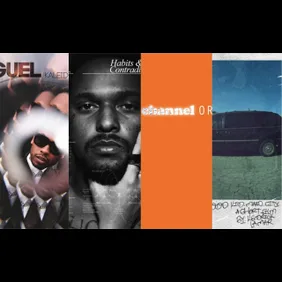
2012: a strong r'n'b showing and the TDE takeover commences
With 2011 serving as the preamble, 2012 was a continuation of strong showings and high profile releases, particularly in the R&B genre. The Weeknd’s Trilogy was a three-hour immersive work of art that remixed and remastered the soaring, atmospheric melodies of his three 2011 mixtapes and compiled them into one package. Frank Ocean’s rare gift of voice and penmanship made for an eloquent debut album, Channel Orange, that featured a novel approach to exploring emotions through rich tales about crack addicts, Egyptian queens, and iconic film characters. The charming undercurrents of love and longing were matched only by Miguel on Kaleidoscope Dream, a gem of an album that was in a dead heat with Channel Orange for the top spot in R&B. Miguel’s sensual croonings made for giddy love songs driven by infatuation and the desire for intimacy. Sometimes modest, other times sardonic, Kaleidoscope Dream helped set the bar for R&B releases in the years to come.
----
The release of good kid, m.A.A.d city at the tail end of the year cemented Kendrick Lamar’s status as The Best Rapper Alive. To say that GKMC is an impressive conceptual recipe would be a severe understatement and a disservice to Kendrick’s artistic brilliance. The complexities of his story and struggles, and the subtleties to the way that he related to the objects, institutions, and people in his community made for a breakthrough that caught everyone’s attention. Suddenly, the early comparisons to other legends didn’t seem so farfetched. King Kendrick had arrived.
----
Back from the Dead and subsequently Finally Rich forced Chief Keef into the role of elder statesman for Chicago’s drill scene. Everything about the “Chiraq” teen was one-of-a-kind: Sosa’s music was unnerving, choppy, and bristling with slang and gunfire, a style that would eventually become a reference point in rap. The 17-year old Brooklyn rapper and old soul Joey Bada$$ revealed himself to be a true rap prodigy on songs like “Waves” and “Survival Tactics.” His debut mixtape 1999 exposed his PRO ERA crew to a wider audience through jazzy production and beats that embodied the timeless New York boom-bap aesthetic. Nas sounded weary and disinterested on his three previous efforts, but the summer-light production of Life Is Good was freeing and brought the Queensbridge poet back to his roots in a way that allowed his craftsmanship to flourish. Kendrick’s labelmates, ScHoolboy Q and Ab-Soul, followed his lead with noteworthy releases that saw Top Dawg Entertainment’s stock shoot through the roof. Q’s Habits & Contradictions was characterized by an enthralling gangster spirit, while Ab-Soul’s Control System was a ferociously creative melting pot fueled by introspection and experimentation in light of the loss of his longtime girlfriend Alori Joh. R.A.P. Music, Killer Mike’s southern-fried solo project, rivals anything in the Run the Jewels discography. Action Bronson, the Flushing, Queens emcee who enjoys juicy food references and caricatured crudeness, served up a referential feeding frenzy on Blue Chips. Wide-ranging and poetic, Macadelic was defined by Mac Miller’s insistence that he had decided to "stop thinking about what kind of music [he] should make and just start saying what [he] wanted to say.” Rick Ross’ Rich Forever managed to deliver even further on the rugged braggadocio of Teflon Don. Blog favorite Freddie Gibbs executed his gangsta formula to perfection on Baby Face Killa, a mixtape that portrayed the heartless street dealer’s life with robust raps over crisp production from the likes of Static Selektah and DJ Mustard. Big Sean’s Detroit, which broke the internet when Datpiff crashed seconds after its release, was a turning point in the Detroit emcee’s career in that is proved he could pull off a full body of work on his own. Described by Pitchfork as “an hour of shouting that sounds like a hug,” Salute Me or Shoot Me 4: Banned From America found Waka Flocka sounding as fresh as ever over Southside production. And the crazed noise rap and delicious chaos of Death Grips’ The Money Store resulted in an album that was confrontational and abrasive from start to finish.
2014
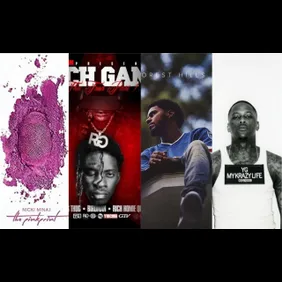
2014: a new generation of artists truly begin to thrive, as "virality" emerges
2014 had a little bit of something for everyone: J. Cole “went platinum with no features”; Nicki Minaj stepped up to the plate battle-ready; Young Thug continued to flesh out his status as a household name with the Top 40 hit "Lifestyle." 2014 Forest Hills Drive didn’t birth any big singles, but still managed to sell 371,000 copies in its first week, giving Cole his third No.1 album and strengthening his place in both the mainstream and conscious-rap crowd. Minaj’s Pinkprint oozed sex appeal like much of her previous material, but also offered a more balanced approach in its blend of pop-rap and provocative sing-song tendencies. Her supercharged adaptability led her to up the ante from “50K for a verse” on “Monster” to “$250,000 for a verse” on the remix to YG’s “My N***a.” The aforementioned “Bompton” rapper gave new life to the West Coast G-funk sound that defined the ‘90s on My Krazy Life, a commercial street rap album produced almost entirely by DJ Mustard. After a fourteen year absence, D’Angelo returned with Black Messiah, the neo-soul landmark of this century that offers plenty to unpack and dissect with each listen. ScHoolboy Q delivered one of the most enjoyable releases of the year with Oxymoron, an album that set the tone with cover art featuring his daughter posing for the camera in a ski mask. The project showcased the warring sides of a man torn between the streets and his responsibilities as a father. Q’s sense of humor and playful drug trafficking goon rap generated gripping imagery and first-person stories from the frontlines.
----
Rich Gang’s virtuosic Tha Tour Part 1, courtesy of Lil Wayne’s budding associates' Young Thug and Rich Homie Quan, allowed “the hardest duo since Outkast” to shine with the help of executive-producer London on da Track. Travis Scott's hype blossomed with the release of Days Before Rodeo, while Migos proved their chops with two mixtapes in one year: Rich N*gga Timeline and No Label II. The maniacal production of El-P paired with Killer Mike’s fiery delivery and lyrical barrage resulted in Run the Jewels 2, an album that embodied the intense revolutionary energy of the political climate and rising #BlackLivesMatter movement. Isaiah Rashad’s Cilvia Demo was further proof of TDE’s ability to nurture under-the-radar talent. On LP1, FKA Twigs explored her fantasies and mystique by pulling off risks that other “pop” artists would never dream of attempting. Logic’s Under Pressure showcased the technical skills of the rising DMV emcee. Mac Miller’s Faces was just as technically sound, but was considerably more daunting and directionless in its 24-track dive into the realities of self-destruction and self-medication. Piñata, the joint album between Freddie Gibbs and producer Madlib, was a cinematic masterpiece on which Gibbs’ street tales flourished in a way that they hadn’t before over velvety, ‘70s-sampling production.
2010
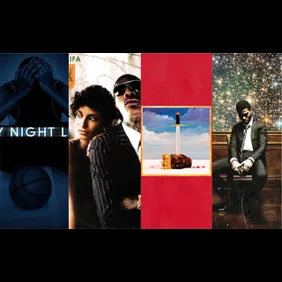
2010: hip-hop's evolution at a crossroads
In 2010, hip hop’s state of evolution was shaky at best. Lil Wayne faced an imminent jail sentence due to a guilty plea on attempted gun possession charges, and his unlikely rock album, Rebirth, was admittedly not the logical follow-up to 2008’s immensely popular Tha Carter III. The exaggerated, angsty parodies of alternative rock contemporaries featured plenty of inanity, and made for an abhorrent combination of styles that resulted in a flat-out flop. His pre-jailtime work on I Am Not a Human Being, released while he was serving his sentence at Rikers Island, was nothing more than a feeble reminder of his existence and a forgettable precursor of what was to come on Tha Carter IV. Eminem continued his journey out of depression and drug addiction on Recovery, an album that pulled out every pyrotechnical trick in the book, but only managed to be a confused attempt to acclimate to the changing pop landscape. Kid Cudi’s Man on the Moon II: The Legend of Mr. Rager, full of forlorn melodies, empty spaces, and riveting production, was an exploration into the unknown made up of grungy records that were deeply at odds with mainstream music.
----
Of all the usual suspects who could have owned the airwaves in 2010, it was none other than Kanye West who picked up the slack and delivered the greatest album from one of the greatest artists of this generation. My Beautiful Dark Twisted Fantasy, set in the midst of his post-Swiftgate comeback, dredged up Kanye’s ego through boundless ambition and vivid portraits of superstardom. Kanye’s creativity was fully realized in one grand, bombastic statement of artistry that was both a career and genre-defining moment. Instead of imploding, Kanye turned tragedy into triumph and emerged from the ashes anew, stoking the flames with his weekly, acclaimed G.O.O.D. Fridays promotional releases. It’s worth noting that he managed to coax two of the best verses of the year out of Nicki Minaj and Rick Ross on “Monster” and “Devil in a New Dress,” respectively. Nicki’s swagger and ferocity were equal parts flamboyant and cartoonish, and her smooth shifts in character and voice drove the modern pop leanings of Pink Friday. Though the attention-grabbing barbs of 2009’s Beam Me Up Scotty were slightly diluted on her debut studio album, it was apparent that the multifaceted talent had more in store. Nicki proved that she had what it took to infiltrate rap’s boys-club, and she was dead set on busting down the door in the process. On his fourth studio album, Teflon Don, Rick Ross came into his own, exploiting the luxurious rap niche with an aura of authority that made for a remarkably lean, if indulgent, listening experience.
----
2010 was the dwindling peak of the mixtape era, one in which the distinction between mixtapes and albums gradually disappeared. Several artists released projects that not only acted as standalone releases, but also doubled as some of the best mixtapes of the millennium.
On K.R.I.T. Wuz Here, Big K.R.I.T. successfully wore the hat of rapper-producer and put himself in a position to be a torchbearer for the south. With cover art jacked straight from David Ruffin’s Gentleman Ruffin, Wiz Khalifa’s Kush & Orange Juice launched the legend of Wiz with free-spirited, zoned out bangers made in the same vein as “Black and Yellow,” the ode to his hometown Pittsburgh Steelers that eventually found its way on to his debut album Rolling Papers. The widely positive reception to Friday Night Lights standouts like “Villematic” and “Back To The Topic (Freestyle)” proved to the world why HOV took J. Cole under his wing in the first place. Although Earl Sweatshirt’s prodigious Earl had a short runtime of 30 minutes, it presented itself as the lyrically dense work of gifted writer having a field day with foul language and absurdist scenes. Mac Miller’s K.I.D.S. was a breezy backpack rap soundtrack that featured feel-good summer tunes like “Nikes On My Feet” and “Kool Aid & Frozen Pizza.” Kendrick Lamar rounded out a year full of career-launching mixtapes with the breathlessly complex Overly Dedicated, a revelatory moment in Kendrick’s discography in which his intimate spoken-word flows, and multiplicative styles and voices began to take shape.
----
Big Boi’s Sir Lucious Left Foot: The Son of Dusty Chico, with its wily dirty South subject matter, exceeded high expectations and laid to rest claims that he was the lesser emcee playing second fiddle to Andre’s mind-bending vision. Wale bounced back from his major label trials, and once again sourced Seinfeld with the independently-released More About Nothing mixtape. The Roots’ How I Got Over, which came on the heels of their last two excellent Def Jam releases, was as versatile and uncompromising as ever in its sense of purpose and rigorous musical standards. Accompanied by the thundering production of Lex Luger, Waka Flocka’s Flockaveli was 17 tracks of unrepentant street rap characterized by uncontained aggression and the roughneck adrenaline of a jackhammer. Then there was Drake’s Thank Me Later, an album from the first of many post-808s & Heartbreak rappers that elevated October’s Very Own from Toronto has-been to bonafide hit-maker.
2016
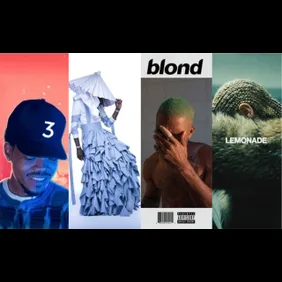
2016: r'n'b is at the forefront, while mixtapes push boundaries to compete with albums
Hip hop took a backseat in 2016, as singers and rapper-singer hybrids released definitive albums and creative mainstays ventured into uncharted waters. Beyonce graced music with her magnum opus Lemonade, an album that lifted the veil of perfection and invited listeners into the specifics of a marriage tainted by infidelity. Released alongside a full-length film, Lemonade shrugged off the competition and the formulaic proclivities of modern pop. Solange’s A Seat at the Table brilliantly handled issues of racial prejudice and self-acceptance, and offered an untempered reflection of the woman behind the mic. Childish Gambino’s Awaken, My Love! was a hard left turn that ditched rap to achieve a genuine level of connection that was at times absent from his previous work. Glover’s role as an observant funk worshipper with a feel for music’s history was amplified by the intricate and painstakingly detailed production. Anderson .Paak, Dr. Dre’s up-and-coming protege, released two albums: Malibu, with its expansive themes that arrived at the intersection of bravado and poise, and Yes Lawd!, the intricate collab album made in conjunction with dynamic producer Knxwledge. Dvsn, comprised of OVO producer Nineteen85 and singer Daniel Daley, released the elusive and sexually serious Sept. 5th, an album that established the duo as resolute R&B innovators looking to ride Daley’s gripping falsetto and purposeful anonymity. And finally, Frank Ocean returned to the fold after a tantalizing four-year hiatus. Peeling back the layers of Blonde is part of its infinite appeal: the defiance of conventional song structure made Frank’s address of existential questions on his winding road to self-discovery that much more poignant.
----
But 2016 belonged to Chance the Rapper. At a time when the country was fraught with rising political and racial tensions, the unadulterated joy of Chance’s Coloring Book was a wondrous escape. His nimble, inventive approach, and commitment to his artistry and staying independent allowed him to carve out a sound that bottled every feeling of every word. Earnest, empathetic, and euphoric, Coloring Book was Chance’s declaration to the world that goofy, good-hearted music still had a place in a genre oversaturated by trap. His savvy decisions (namely garnering the backing of Apple) not only catapulted him into the limelight but also proved that success from the internet can come in many different shapes and sizes. Chance’s verse on Kanye’s The Life of Pablo intro “Ultralight Beam” was the best of the year, and he continued his run of rapturous expressionism on standout tracks like “No Problem,” “Angels,” and “All Night.”
----
6LACK’s FREE 6LACK offered bleak, low-energy depictions of alt-R&B. Even in the absence of frequent collaborator DJ Mustard, the production chemistry and celebrity gangster of YG’s Still Brazy spun several generations of west coast sound into one full of foreboding and paranoia. On Savage Mode, 21 Savage recounted the violent horrors of his life with a deadpan seriousness that complemented the eerie and brooding production from Metro Boomin. Under the banner of hip hop, Young Thug released two streamlined projects, Slime Season 3 and Jeffery, that displayed his growing mastery of the use of his voice as an instrument. Kendrick Lamar managed to outpace the best years of some of his peers with Untitled Unmastered, a collection of studio leftovers that kept his name in the conversation. Rihanna dabbled with whatever tickled her fancy on Anti and still managed to land three top 10 singles, while tag-team Rae Sremmurd buckled up for the second installment of their relentless party-rap series. Konnichiwa, the Mercury Prize-winning album from grime pioneer Skepta, snarled at the industry’s preoccupation with image. With warm and inviting sonic brush strokes and Ariana Grande acting as his muse, Mac Miller attempted to decipher the subtleties of love on The Divine Feminine, the most accomplished release of his career. ScHoolboy Q’s rough-edged personality and tough talk acted as the outer layer to the sandpaper rhymes of his Blank Face LP. And A Tribe Called Quest, one of the greatest acts that hip hop has ever produced, released their first album in eighteen years. The forward-thinking and poetic We Got It from Here… Thank You 4 Your Service, recorded just before the death of Phife Dawg in March 2016, was heavy with his presence. Choosing not to rest on nostalgia, the album was comprised of bright and uncluttered instrumentation that conveyed worldly observations while also revealing the deep-seated racism of America.
2017
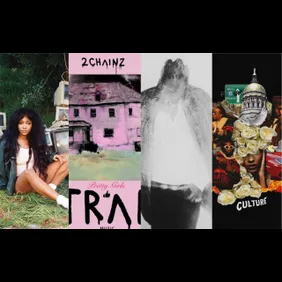
2017: a constant stream of releases, maturation of once-newcomers, and a nod to the socio-political landscape
2017 was a year of artistic achievement for everyone from Daniel Caesar to Rapsody to 2 Chainz. Caesar’s Freudian was a beautiful love letter that explored the highs and lows of a relationship with remarkable transparency and the wide-eyed innocence of someone navigating a slowly crumbling romance. On Laila’s Wisdom, Rapsody linked with former Little Brother producer 9th Wonder to deliver an album centered around self-love and dedicated to her departed maternal grandmother. Pretty Girls Like Trap Music, the most complete and fulfilling 2 Chainz project to date, found the 39-year-old hitting his stride with the same laidback grit and hustle of old. SZA wrestled with mental and emotional stress on Ctrl, Kehlani’s conversational tone on SweetSexySavage placed emphasis on reclamation, and Jhené Aiko’s Trip featured 22 tracks of enlightenment and healing. R&B newcomer Khalid drifted through funky mall pop and sizzling basslines with a youthful, nonchalant drowsiness on American Teen, while Miguel’s War & Leisure throbbed with kinetic energy in its search for spiritual freedom and greener pastures. Tyler, the Creator’s unique success blossomed on Flower Boy, his Grammy-nominated album that soaked up all the warmth of the Southern California sun. Migos, who struck gold with the massive chart-topper “Bad and Boujee,” harnessed the trunk-rattling trap music of Atlanta and brought it to the mainstream in a way that had never been done before on Culture. Joey Bada$$ made his political intentions clear on ALL-AMERIKKKAN BADA$$, continuing his vehement fight against crooked cops, a broken government, and the terror experienced by people of color nationwide on a day-to-day basis.
----
Four key players, all at very different stages in their careers, set themselves apart from the competition in 2017. Although Cardi B’s unprecedented rise took the better part of the year to gestate, it didn’t take long for the audacious success of “Bodak Yellow” to transform her into one of the rap game’s most polarizing figures. Whether or not onlookers care for her compulsive proclamations and unbridled honesty, the risky jump from celebrity to rapper paid off in a big way, as would become evident with 2018’s Invasion of Privacy. Future, ever the prolific studio rat, dropped surprise albums twice in two weeks, and the pan-flute driven single “Mask Off” was a surefire hit right out of the gate. Both FUTURE and HNDRXX were self-assured and displayed Future’s knack for articulating the juxtaposition of his persona: the antagonistic, street-worn exterior versus the tormented, emotionally volatile man within. It’s difficult to age gracefully in rap, but Jay-Z pulled it off masterfully on his 13th studio album, 4:44. Viewed by many as a response to his wife’s all-consuming release from the previous year, the album was more than just an apology. Jay sounded unexpectedly focused and intentional in his search for peace. 4:44 presented an artist wise beyond his years but finally ready to act his age. Then there was Kung-Fu Kenny, who addressed the doubters and staked his claim to the throne on “The Heart Part IV” before releasing the visceral DAMN. Though no one was sure where Kendrick would take his career next, he fine-tuned the best qualities of his previous work to create an album that was explosive, heartfelt, and timely all in one. Best of all, he didn’t concede any creative ground in the creation of his most mainstream-accommodating project to date, further solidifying his place as hip hop’s most daring star.
----
Lil Peep and XXXTentacion, two leaders of the “SoundCloud rap” scene, burst into the public’s consciousness with Come Over When You’re Sober, Pt. 1 and 17, respectively. Southern rap traditionalist Big K.R.I.T. released 4eva Is a Mighty Long Time, a double album with booming bass lines and candy-painted Cadillacs on one side, and composed vulnerability on the other. Vince Staples sounded as clever and boisterous as ever over the sleek, electronic-based production of Big Fish Theory. The quintessential postmodern rapper, new age rockstar and emo-rapper trendsetter Lil Uzi Vert released an album, Luv is Rage 2, that trembled with an inescapable punk energy. And dvsn’s melodramatic and meditative Morning After extended the narrative of Sept. 5th, as the duo continued to ponder old flames with a pronounced air of mystery.
2018

2018: hip-hop's commercial and pop culture appeal hits an all-time high
Hip-hop has never been more commercially viable than it is in 2018. There is a thriving underground movement, the biggest stars are at the apex of their powers, and the genre boasts some of the most recognizable faces in the industry. Though 2018 is not yet over, the past year has already been filled with a number of high profile releases and memorable moments, perhaps none more so than the beef between Pusha T and Drake. On the seamlessly pure and airtight Daytona, the first of five albums to emerge from Kanye West’s Wyoming recording sessions, Pusha basked in brevity and production that fit his fearlessness. The underlying cravings for confrontation came to a head with the malicious “The Story of Adidon,” a track that continues to saturate the public discourse five-plus months after its release. It was the perfect storm: Pusha stood toe-to-toe with Drake, laughed in the face of decorum, and surgically dismantled the biggest rapper on the face of the planet with unsettling ease. In choosing to focus on Drake’s character and personal relationships, Pusha blew his opponent’s cover and tarnished his image in a way that no other competitor had done before. “The Story of Adidon” was the kind of cold-blooded record that would put any other rapper six feet under.
----
Although the altercation revealed chinks in Drake’s armor, he ultimately won the war, continuing his nine-year monopoly of the Billboard charts. His double album Scorpion didn't exactly impress as a cohesive body of work, but “God’s Plan,” “Nice For What,” and “In My Feelings” spent a grand total of six months on top of the Hot 100, one of the most impressive individual stretches in music history. Having just announced plans to get to work on a new album once his “Aubrey & the Three Migos Tour” wraps up, it appears that Drake has no plans of letting up any time soon.
----
Elsewhere, Jay-Z and Beyonce released Everything Is Love, an album that examined the power couple’s cult of personality through the lens of opulence. Far beyond the honeymoon phase, their liberating public vow renewal culminated in tales of resilience, sustainability, and lavish love. Brockhampton, the self-described boy band and most exciting group in hip-hop, maintained the momentum that they achieved with the sublime Saturation trilogy and dropped iridescence, a mishmash of influences pummeled into a collection of scatterbrain sights and sounds. On the highly-anticipated Astroworld, Travis Scott embraced his role as hip hop’s next great orchestrator and put together a project that felt like his most magnificent symphony to date. Laced with just enough ad-libs and Houston flair, the album played into the amusement park motif, creating a surreal ride full of druggy trips and heart-racing, whiplash surges of adrenaline. J. Cole’s K.O.D. dealt with issues of addiction, infidelity, fame, and over-indulgence but with a twist that mirrored modern rap’s much-discussed generation gap. The feverishly anticipated Black Panther soundtrack, curated by Kendrick Lamar and director Ryan Coogler, was a historical moment that not only embodied the heart and soul of Wakanda, but also served as a box office sized reminder of “hip hop’s emergence as the primary driving force in popular culture.” Throughout Die Lit, Pi'erre Bourne, the mad scientist responsible for concocting "Magnolia" and "wokeuplikethis*,” whipped up an intoxicating spread of onomatopoeic effects, 8-bit melodies, 808 patterns, and ambient noises to accompany the torrid onslaught of ad-libs that have become Playboi Carti's modus operandi. Mac Miller’s Swimming found the young artist exploring his heartbreak and fragile mental state through self-deprecating humor, all the while trying to keep his head above water. Kids See Ghosts’ self-titled release featured two artists reclaiming their peace, as Kanye’s boisterous vocal performances were deftly mixed with Cudi’s otherworldly howls and soothing hums. Cardi B continued her bloody-shoed Billboard chart run, proving she was more than just a novelty act or a rookie with a hot song. Beyond Cardi’s Invasion of Privacy and Nicki Minaj’s Queen, 2018 featured an improved representation of women in hip hop: Tierra Whack turned heads with her avant-garde visual album Whack World; Rico Nasty fused sugar trap with death metal on Nasty; CupcakKe’s Ephorize was both riotously funny and x-rated; and Noname’s transcendent Room 25 revealed profound internal transformation. To top it all off, Childish Gambino’s thought-provoking “This Is America” became one of the hottest songs of the summer, Kevin Gates was released from prison and made a triumphant return with Chained to the City EP and Luca Brasi Story 3, Eminem returned to the fold to address critics on Kamikaze, Lil Wayne’s Tha Carter V finally saw the light of day, and Kendrick Lamar won a Grammy. We're not even done yet.
----
Care For Me, Saba’s eulogy for his fallen cousin and crew member John Walt, was elaborate and sprawling in its refusal to settle for banality. Denzel Curry’s three-act concept album TA13OO yielded the raw hardcore hip-hop that fans have come to appreciate, and proved that he’s only gotten better with each release. On the long-awaited Victory Lap, Nipsey Hussle was both parts self-made hustler and motivational speaker, stringing together gruff and detail-filled aspirational raps. Dev Hyne’s Negro Swan, released under solo project moniker Blood Orange, was sensitive and radical in wrestling with racial identity. SiR, the wunderkind with writing credits for Anita Baker, Jill Scott, Tyrese, and Latoya Luckett, channeled his lackadaisical vocals to produce the serene funk of November. Riding the viral success of “Mo Bamba,” Sheck Wes released MUDBOY, a slew of coming-of-age tales ensconced in murky trap. Lil Baby and Gunna experienced breakout success, becoming ones-to-watch and breathing new life into Atlanta trap. West coast R&B group The Internet, founded in 2011 by two members of Odd Future, showed greater depth on Hive Mind with a blend of soul, jazz, and hip hop. The Weeknd sought solace in the past on My Dear Melancholy, an album full of sordid singing and hopelessly moving production. Just like the original, Future’s Beast Mode 2 was produced entirely by beat-maker Zaytoven and was marred by emotional and psychological turmoil that unearthed new creative spoils.
2015
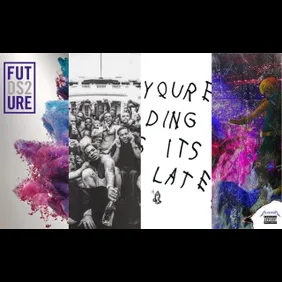
2015: heralded releases from major artists coupled with career-defining debuts
2015 featured a trifecta of rappers at the pinnacle of their powers. Kendrick Lamar followed up his critically acclaimed major-label debut with perhaps the most ambitious rap album of the past decade. To Pimp a Butterfly dug deeper into the psyche of Kendrick and his journey out of Compton. Not only did it examine his soul and relationship with the world around him, but it painted a picture of a black man navigating the pitfalls of success. In his odyssey to question everything, Kendrick forced fans, critics, DJs, and other musicians to look beyond the music. TPAB was arguably the single most important album of the year.
----
Future’s improbable run over the course of 2014 and 2015 remains one of the most impressive in recent memory. Perhaps it was the dismal response to Honest that led him to pursue therapeutic prolificacy. Or maybe it was his messy split with singer Ciara. Whatever the reason, Future roared back to life with his career teetering on the brink of destruction. His compelling mixtape trio of Monster, Beast Mode, and 56 Nights received a fitting finale in the form of Dirty Sprite 2, an album that brought his drug-addled susceptibilities to the forefront through an acute sense of self and bewilderingly mind-numbing flashes of anguish. Future’s feelings of detachment and loss were mixed into the swirling purple drank in his styrofoam cup, creating his most consistent work to date.
----
But neither Kendrick or Future could hope to top the indomitable force that is Drake. If anything, Drake’s response to the career-threatening ghostwriting accusations levied by Meek Mill is the most telling when it comes to understanding why 2015 is the unequivocal centerpiece of his career. For a week and a half in July, the world watched in awe as Drake copped to the accusations and delivered a biting diss track in “Back to Back” that not only put to rest Meek’s attack on his credibility, but subsequently turned the incident into a crowning occasion. “Back to Back” went on to become the first-ever Grammy nominated diss track, but not before Drake dropped “Hotline Bling,” a song that now stands as yet another inescapable reminder of his sheer ubiquity. If You’re Reading This It’s Too Late is a sleeper pick for the best album in his discography, while What a Time to Be Alive, his joint project with Future, illustrated Drake’s unparalleled efficiency at co-opting and refining any sound for maximum effect. In a year that saw him rack up one big win after another in seeming cruise control, Drake became more than just music’s biggest star. He had withstood the blows of his foes and emerged on the other side more powerful than ever.
----
Dreams Worth More Than Money proved to be the root of Meek Mill’s demise at the hands of Drake, but it still managed to deliver some high watermarks buoyed by his hard-hitting intensity and battle-rap gut checks. SremmLife, the debut album from Atlanta-via-Tupelo brothers Swae Lee and Slim Jxmmi, crammed earworm hooks into every nook and cranny to create an entertaining back-and-forth vocal dynamic. Jeremih’s impeccably produced Late Nights was well worth the wait, tracing the sunset to sunrise debauchery of one of R&B’s most intriguing players. No one could have predicted the eventual popularity of Bryson Tiller, but his genre-straddling Trapsoul created a personal narrative that stuck out in a world full of Drake wannabes. Lil Uzi Vert’s Luv Is Rage was drenched in autotune, woozy beats, and ample lo-fi effects. Chance the Rapper may have been the main attraction of Donnie Trumpet & the Social Experiment’s Surf, but the group lifted the Chicago artist’s gospel harmonies to new heights through the use of an expansive, meandering mosaic of sounds. Travis Scott, a member of the Kanye think tank with a number of connections that aided his rise to prominence, built off the buzz of the phenomenal Days Before Rodeo to deliver Rodeo, full of gorgeous production and harshly distorted mumblings. Earl Sweatshirt exorcized his sorrows on the heavy I Don’t Like Shit, I Don’t Go Outside. Vince Staples’ Summertime ‘06 stared into the rap abyss and emerged from the haunting inferno on a twisting and turning ride through Long Beach. Following the death of A$AP Yams, A$AP Rocky’s At.Long.Last.ASAP wasn’t just an elegy to his best friend’s teachings. The “L$D” emcee proved that he was more than the sum of his inspirations, and highlighted his growing taste-making ability. On Compton, Dr. Dre’s first record in sixteen years, the super producer sounded charged-up. Bundled with the blockbuster movie Straight Outta Compton, the communal project featured orchestration that was just as aggressive as ever, but didn’t strain for relevancy or try to overcompensate for lost time. Young Thug’s compositional talents and unclassifiable, unpredictable vocals were utilized on Barter 6 to piece together zany melodies that accentuated his artistic contradictions. Miguel and The Weeknd delivered albums with new formulas that drew them in completely different directions. The former’s Wildheart, a culmination of years of cross-genre experimentation, focused on pleasure and carnal pursuits with a sex-positive attitude that shifted between tender and pornographic, while The Weeknd’s Beauty Behind the Madness featured plenty of familiar references to cocaine and sex, but was hellbent on stardom above all else.
2011
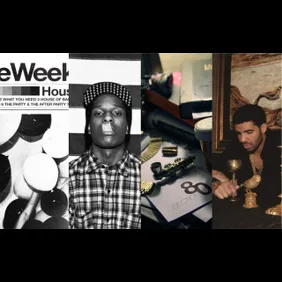
2011: the changing of the tides
If 2010 was the rollout of the OVO red carpet, then 2011 was the year that Drake claimed his rightful place atop the hip-hop hierarchy. Take Care was more than just the realization of Drake’s superstar potential. It was a sophomore album with an undeniable influence on which the modern day Romeo flaunted his gentlemanly characteristics and bled his broken heart onto wax for anyone who would listen. On tracks like “Club Paradise” and “Marvin’s Room,” Drake made his struggles feel universal, as he channeled his accomplishments, selfishness, and complicated relationships with women into relatable vignettes. Take Care was also the beginning of Drake’s reign as a kingmaker: he would go on to bequeath hit records to the likes of 2 Chainz, A$AP Rocky, DJ Khaled, and French Montana.
----
While Drake’s emergence was certainly the focal point of year, 2011 featured a diverse and talented cast of newcomers. LIVE.LOVE.A$AP, with its internet-rap and fashion-sensibilities, was an amalgamation of influences packed into A$AP Rocky’s Harlem pedigree. His hubristic flow and attention to pop culture ushered in a new era that culminated in the globalization of the “cloud rap” sound. Danny Brown’s XXX, a wacky tribute to the pill-popping lifestyle, was defined by the Detroit emcee’s unrelenting individuality and incomparable voice and persona. The release of Tyler, the Creator’s Goblin at the start of the decade led the viral antics of OFWGKTA, a collective of misfits and self-aware kids making art that was beholden to no one. Emanating from the heart of Compton, Kendrick Lamar’s stellar Section.80 was the prelude to his masterpiece introduction to the world. The delicately beautiful and melancholic nostalgia, ULTRA. confirmed Frank Ocean’s genius. And in the great white north, the beginning of Abel Tesfaye’s journey to become “starboy” on House of Balloons irrevocably altered the R&B landscape. Unhinged hedonism and a captivating examination of humanity’s darkest desires were packaged in a flashy shell trademarked by the now world-renowned popstar.
----
J. Cole’s Cole World: The Sideline Story may not have delivered on the sound of his diaristic mixtapes but still showed tremendous promise. Wale’s Ambition took the previously unmarketable wordsmith and rebranded him through the gleaming production that was the brainchild of Rick Ross’ ascendent Maybach Music. On the DJ Drama-hosted Dreamchasers, Meek Mill’s first solo MMG endeavor, the ferocious Philly street rapper’s larger-than-life ambition and thrilling sense of urgency gave way to his now familiar barking cadence. The custom-built Return of 4eva displayed Big K.R.I.T.’s mastery of the classic Southern rap tracks that influenced his upbringing. T.R.U. REALigion embodied 2 Chainz’ indescribable essence, as he assembled an all star roster of producers and abandoned the TityBoi moniker in favor of a new name that he could shout at the top of his lungs. The moody weight of The Roots’ Undun made for a concept record and character study that examined the futile inevitability of life through nuanced allusions and brilliant script writing. Beyonce’s 4 dealt with monogamy, loyalty, and the inner workings of lifelong commitment in a manner that exhibited her growing sense of maturity and willingness to take risks. To close out the year, lauded rap superheroes Jay-Z and Kanye West joined forces on Watch The Throne, a record built on black excellence and the exhilarating celebration of notoriety and legacy.
NOW, WHICH YEAR WAS YOUR FAVORITE?
